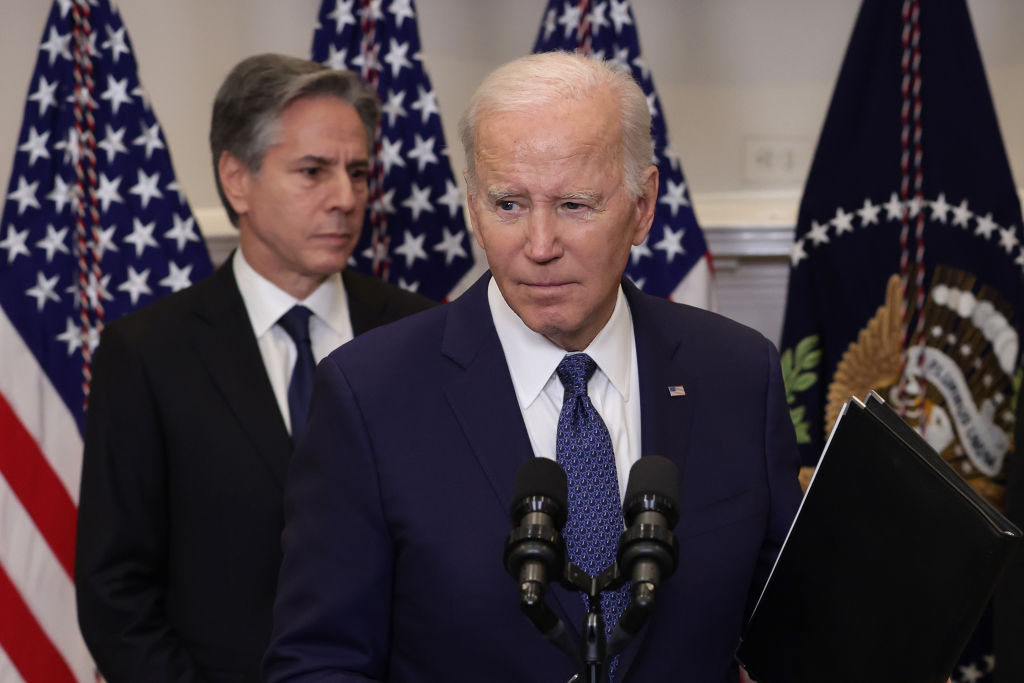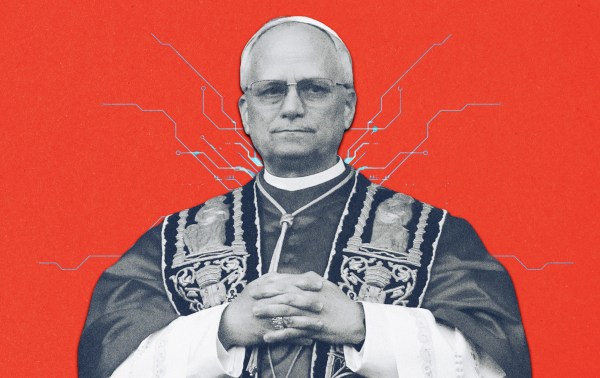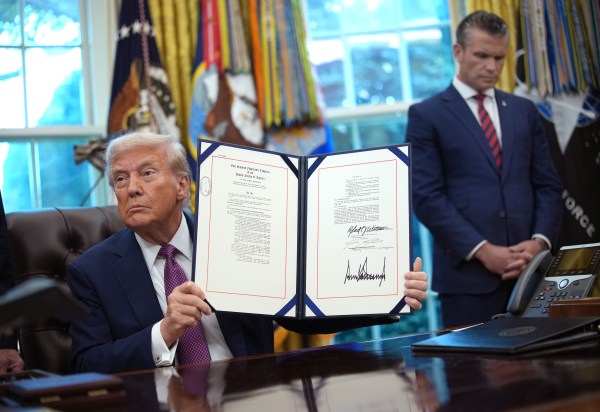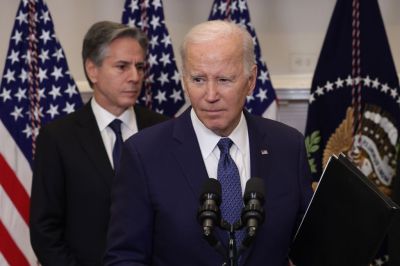President Joe Biden’s decision to trade $6 billion for five American citizens unlawfully detained in Tehran isn’t just the largest hostage ransom payment in American history—it’s also the second phase of an unacknowledged agreement with Tehran that strengthens the ayatollah’s position in the Middle East and frees the regime to cross the nuclear weapons threshold at a time of its choosing. Americans need to brace themselves for the consequences of both realities.
What would normally be a celebratory welcome home for our fellow Americans is now overshadowed by the methods used to win their release and the implications of a foreign policy bent on appeasing the world’s leading state sponsor of terrorism. That the White House announced this deal during the August congressional recess was no coincidence. Emergency hearings cannot be held. Resolutions of disapproval cannot be fast-tracked. President Biden has successfully evaded the Iran Nuclear Agreement Review Act, which requires him to notify Congress of any agreement with Iran related to its nuclear program before lifting sanctions.
If Biden’s malpractice was confined to paying enormous sums to win the freedom of American hostages, the ramifications would be bad enough. In 2015, President Barack Obama agreed to pay Tehran $1.7 billion for the release of four Americans as part of the broader negotiations over the first Iran nuclear deal. Predictably, Iran took more hostages in the months and years thereafter, believing it could get an even better price from a future U.S. president. The Trump administration turned to pressure instead of ransoms and won the release of two hostages without paying a dime. But under Biden, ransom payments have returned—at nearly three times the cost. While the Obama administration paid $425 million per American in 2015, the Biden administration has agreed to pay $1.2 billion.
History teaches us that Iran will only be emboldened by this swap, taking additional Americans hostage in the months and years to come. But unfortunately, that may be the least of our problems. Russian President Vladimir Putin’s decision earlier this year to seize Wall Street Journal reporter Evan Gershkovich represented a significant escalation in Russia’s own hostage-taking playbook. Rather than immediately pressuring Russia to release Gershkovich, President Biden has allowed him to sit in prison while the U.S. waits to hear Putin’s list of demands. And after last week’s Iran trade, the price for Gershkovich undoubtedly went up considerably.
More concerning, however, is what the Chinese Communist Party has in store for Americans who work and travel in China. Beijing recently unveiled a new espionage law that prompted the U.S. State Department to warn Americans they could be taken hostage in China at any given moment. Biden’s ransom payment to Iran may give Xi Jinping the reassurance he needs to greenlight the unlawful detention of an American business leader.
The White House and its defenders claim these concerns are invalid: No ransom is being paid to Iran, they claim, because the money made available to Tehran is the regime’s own oil revenues frozen in South Korea. Is that how Ayatollah Khamenei and his Revolutionary Guard (IRGC) see it—or how Putin and Xi, facing increasing walls of sanctions around them, will see it themselves?
Where the money comes from is irrelevant: The funds—which Gold Star families begged President Biden not to release—were frozen because of Iran’s sponsorship of terrorism and pursuit of nuclear weapons-related capabilities. The bank account in South Korea where this $6 billion will be sourced is currently subject to U.S. terrorism sanctions for its owner’s financing of the IRGC Quds Force. Because banks comply with U.S. sanctions and move money only when the Treasury Department allows, Washington ultimately controls the flow of these funds—and authorizing their release in exchange for hostages is the very definition of paying a ransom.
To defend against the argument that Iran will use the $6 billion to fund terrorism against Americans, send weapons to Russia, or repress women, the White House insists the money can be used only to pay for humanitarian-related expenses. Putting aside how broadly the term “humanitarian” may extend—as well as Iran’s long-track record of conducting illicit transactions disguised as humanitarian ones—there is one inescapable reality: Giving Iran access to $6 billion to subsidize imports frees up $6 billion for other purposes.
As bad as this hostage ransom scheme is, the problems with the Biden administration’s deal extend far beyond $6 billion. This move is a new phase of a larger protection racket designed to put off a showdown over Iran’s nuclear program until after the 2024 presidential election.
After more than two years of policy failure—offering Iran massive sanctions relief to return to the 2015 nuclear deal while allowing Tehran to enrich more uranium to higher levels than ever before—the Biden administration faced an increasingly likely prospect that Iran would become a recognized nuclear threshold regime on its watch by producing weapons-grade uranium. The White House faced a choice: Establish a credible military threat to deter Iran from further nuclear escalation and restore a maximalist sanctions approach, or offer to pay Tehran’s price to postpone a crisis for 18 months. President Biden chose the latter.
In early May, Biden’s Middle East czar passed messages to the ayatollah through Oman, suggesting both sides agree to a temporary period of de-escalation wherein the U.S. would loosen its grip on Iran’s economy and Iran would hold off on enriching uranium to weapons-grade purity. The arrangement would not be labeled a “deal,” since a “deal” would need to be submitted to Congress for review—and possible rejection. Instead, Washington would open all relief valves it could find without triggering a 2015 law that gives Congress the right to veto such an arrangement.
For Tehran, the deal is a gift from above. No dismantlement of its enrichment infrastructure. No setback to its nuclear or missile capabilities. No snapback of U.N. sanctions. No end to assassination plots against former U.S. officials. No pullback on the sponsorship of terrorism. Freedom to keep building a new underground site that could prove impenetrable to military attack. Continued drone transfers to Russia. The expiration of an international missile embargo on Iran in October. A green light to crack down on Iranian women and dissidents.
To access all that and more, all Iran must do is not enrich uranium to a higher level and give the appearance of slowing its production of highly enriched uranium—even though the 60-percent-enriched uranium it produces every day is already 99 percent of the way to weapons-grade. The deal is exactly what Iran wants: Maintain the stockpile and technical capacity to rapidly produce weapons-grade uranium until its advanced centrifuges are perfected and its new underground facility completed. When that day comes, the game is over and Khamenei wins.
In June, the U.S. authorized the release of $2.76 billion of frozen Iranian funds held in Iraq to help Tehran pay off its debts. In early July, an Iranian official claimed the regime had received access to $10 billion previously made inaccessible by U.S. sanctions. On July 11, Iraq announced it would trade its oil for Iranian natural gas—an arrangement that can only occur with Washington’s approval. Also in July, the Biden administration reportedly authorized Iraq to move Iran’s money to a bank in Oman, which would facilitate transactions for Tehran. Meanwhile, U.S. non-enforcement of sanctions targeting Iranian oil exports hit a new high, with Tehran exporting 1.6 million barrels per day.
How can all this money be flowing to Iran without Congress first being notified and the deal put to a vote? Because the White House has concocted alternative explanations and legal justifications for every move it makes. The $10 billion from Iraq was released under cover of easing the political and economic pressure Iran placed on Baghdad for complying with U.S. sanctions. Both the Trump and Biden administrations had issued sanctions waivers that allowed Iraq to continue importing Iranian energy. Rather than keeping payments for that energy in Iraq, payments will now be made to the account in Oman.
Now comes a supposed hostage trade. A 2012 law prohibits South Korean banks from allowing Iran’s frozen funds to leave their escrow accounts in Seoul without a national security sanctions waiver being issued by the president of the United States. Just as a waiver was required to move $10 billion from Iraq to Oman, one should also be required to move $6 billion from South Korea to a bank in Qatar, as the hostage deal reportedly entails. And since a waiver tied to a hostage deal needs no prior congressional authorization, Congress gets hoodwinked again.
The idea was cooked up last year by then-Special Envoy for Iran Robert Malley as a way of offering Tehran upfront cash as part of a broader nuclear deal that Tehran eventually rejected. Malley exposed the scheme in a tweet in which he thanked South Korea for helping to broker both the return of American hostages and a return to the 2015 nuclear deal by releasing Iran’s frozen funds. While Malley is now sidelined by a mysterious FBI investigation into alleged mishandling of classified information, his schemes live on.
At least $16 billion has now been made available to Iran without any congressional input—and more might be on the way. Another $6.7 billion is reportedly moving to Iran via the International Monetary Fund Special Drawing Rights—an international reserve asset that Tehran can trade with another IMF member to in exchange for freely usable currencies. The process is so opaque and misunderstood that neither the IMF nor the Treasury Department have felt compelled by the media to provide details. Iran’s foreign minister visited Japan last week and reportedly brought up another $3 billion of regime assets frozen in Tokyo. India and China, where banks sit on other large sums of Iranian cash, might be future stops.
The implications are disastrous for U.S. national security. Iran will march its way to the nuclear threshold with America’s blessing, and with a new hardened underground site prepared to complete its nuclear breakout. America will be funding two sides of a war in Ukraine—helping Kyiv defend itself from Iranian weapon shipments subsidized by U.S. sanctions relief. And the women of Iran will stand alone—abandoned by the world’s greatest potential force for good just to avoid making hard decisions until the end of a challenging presidential election cycle.
The world is a scarier place today than it was a week ago. Americans living and traveling abroad have a price tag on their heads. And Iran’s odds of developing nuclear weapons have improved dramatically.






Please note that we at The Dispatch hold ourselves, our work, and our commenters to a higher standard than other places on the internet. We welcome comments that foster genuine debate or discussion—including comments critical of us or our work—but responses that include ad hominem attacks on fellow Dispatch members or are intended to stoke fear and anger may be moderated.
With your membership, you only have the ability to comment on The Morning Dispatch articles. Consider upgrading to join the conversation everywhere.